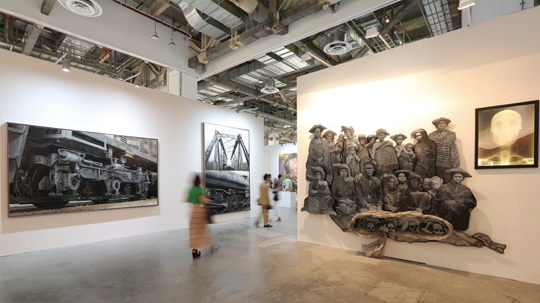SINGAPORE: FUTURE STAR OF ASIA?
| June 4, 2013 | Post In LEAP 20

ART FAIRS PRESENT perfect opportunities to observe the local economy and art ecology. Already in its third year, Art Stage Singapore has again chosen the country’s most luxurious locale, the Marina Bay Sands conference center, as the exhibition venue. A total of 131 galleries from 25 countries participated in this year’s fair. Seventy-five percent of the galleries came from Asia, while the remaining twenty-five percent were international galleries, such as Eigen + Art and White Cube. Yet compared to last year, galleries from China seem to have lost some enthusiasm for the fair, with several previous participants absent, including Tang Contemporary, Xin Dong Cheng Space, Magician Space, and from Hong Kong, Osage Gallery. Downturn of the international art market in 2012 meant that the previous Art Stage Singapore’s sales figures were less than ideal. This year, both the organizers and exhibiting galleries have arrived with different strategies. After Art Basel’s purchase of Art HK, many galleries believe Art Basel HK in May needs to be their top priority. Thus Art Stage Singapore has further clarified its position: to promote Southeast Asian art.
In fact, Singapore has lately given significant state support to its national art and culture, of which the art fair is only one promotional tool. The Singaporean government hopes to build this financial center into a future Asian art hub. After vigorously developing its economy for many years, Singapore now finds itself with an internationally weak cultural image; whether in film, literature, or art, there are very few Singaporeans who can represent their country on the global stage. How to build up its cultural image is an issue that the Singaporean government must confront. In comparison, Hong Kong’s art industry is like a rising star whose happenings are watched by an ever-growing international audience. In the competition for cultural supremacy in Asia, Hong Kong has always been a formidable opponent whose dominance Singapore cannot surpass in a short period. Therefore, the Singaporean government is pouring money into building museums and art spaces. The gallery district Gillman Barracks is one such development. Although still in its early days of operation, 13 galleries have set up shop in the contemporary arts space, including ShanghART Gallery (represents Geng Jianyi and Yang Fudong) from China, Ota Fine Arts (represents Yayoi Kusama) from Japan, and Arndt Gallery from Berlin. Reports indicate that Pearl Lam Galleries of Hong Kong and Japanese artist Takashi Murakami’s art production company-cum-gallery, Kaikai Kiki, also plan on taking up leases starting in 2013. The Centre for Contemporary Art, slated to open in mid-2013, will also have artist residencies and additional exhibition spaces.
Apart from upgrading cultural hardware, Singapore’s National Arts Council (NAC) also makes financial contributions to various art projects. The Singapore Platform at this year’s fair has received monetary support from NAC. Jason Wee is a project curator and participating artist of the Singapore Platform; he also runs an independent art space, Gray Project. Wee admits that in the beginning it was very difficult to operate an independent art space, but having received support from the government in recent years, Gray Project is now operating successfully.
Singapore has always had a healthy business tradition; add to that the government’s support for the arts, the future can only be bright for its cultural ambitions. Yet when one spends time in this excessively polite and extremely clean country, the sense is that a certain vitality is missing from the picture. Singapore guarantees its citizens religious freedom, and many religions of Southeast Asia can find practitioners here. Yet any artwork involving religious content must be cautious of its potential impact. The truth is, many Singaporean artists are fully aware of the restrictions: In an artwork, there cannot be any criticism of the government. An over-reliance on governmental support for art creates its own latent crisis in the local cultural development: How long can the government subsidies and promotions last? (Translated by Daniel Nieh)

